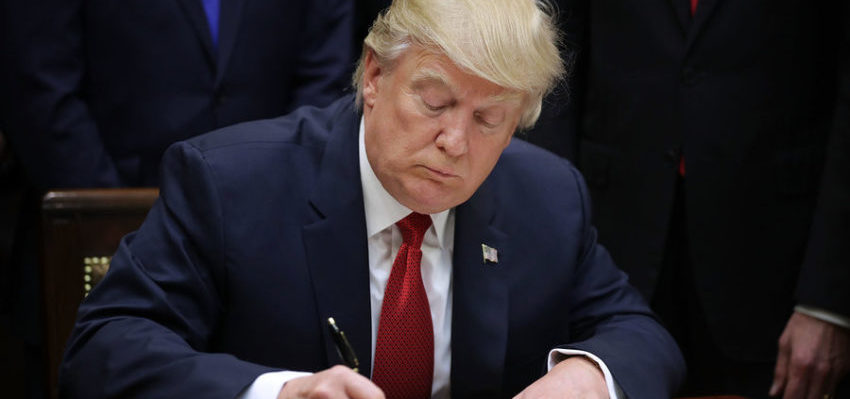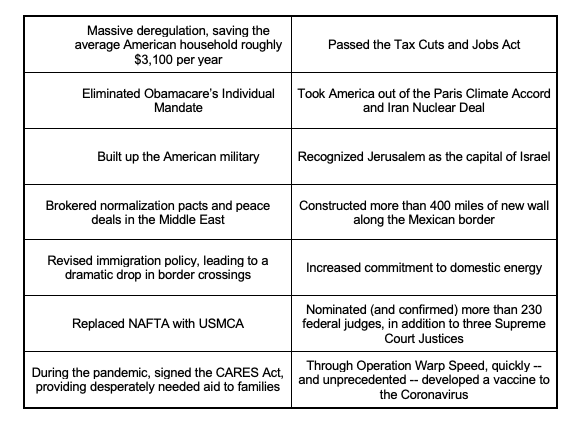
Dan O’Donnell runs down the list of the Trump Administration’s policy accomplishments and makes the case that President Trump had an incredibly successful term in which he advanced conservatism immensely.
@DanODonnellShow - Trump's critics must admit that these policy successes make him one of the more consequential presidents of the past century & the most effective one-term president in history Click To TweetJanuary 20, 2021
Guest Perspective by Dan O’Donnell
If there was a singular theme of the Donald Trump presidency, it was the tendency for both supporters and critics to judge it on the character and behavior of the President and not the substance and impact of his policies. As such, the Trump era ends without the sort of sober analysis that often accompanies the end of presidencies, and this is a shame because, on policy, Donald Trump was perhaps the most consequential conservative in recent history.
The most ardent of Trump’s detractors—both on the left and in the Republican Party—are simply too blinded by unhinged hatred for the man that they are largely unable to see the lengths to which his policies both advanced the traditional conservative movement and moved it into a new phase that has the potential to open it to millions of new adherents.
Simply put, Trump’s presidency proved that tried-and-true conservative principles of tax cuts and deregulation can dramatically improve the nation’s economy, while his more judicious approach to foreign engagement combined with the aggressive pursuit of more America-centric trade exposed the flaws of Bush-era neo-conservatism.
Trump is, of course, a flawed man, and he was far from a perfect conservative, as his administration spent far too much and largely (and shortsightedly) abandoned many of the tough-on-crime stances of the Bush and Reagan presidencies before him. Like Bush and Reagan, however, Trump’s embrace of traditional conservative economic policy led to quite possibly the greatest economic boom in American history.

After a bitter trade war, Trump emerged victorious over China and forced the Chinese to agree to major concessions in a Phase One Trade Agreement that forced Beijing to better police the theft of American intellectual property and purchase an additional $200 billion of American exports.
In one of his very first acts in office, Trump adopted a policy in which his administration would eliminate eight existing regulations for each new one adopted. By the White House’s estimate, this reduced the direct cost of regulatory compliance by more than $100 billion, freeing up the private sector to spend more on wages and reinvestment. This deregulatory push removed nearly 25,000 pages from the Federal Register (by way of comparison, the Obama Administration added more than 16,000 pages) and saved the average American household roughly $3,100 per year.
He then worked with Republican House Speaker Paul Ryan and Senate Majority Leader Mitch McConnell to pass the Tax Cuts and Jobs Act, the single largest tax reform law in American history. The average family saw their income tax bill cut in half, and the reduction in the business tax from 35 percent (the highest in the industrialized world) to a competitive 21 percent prompted employers by the thousands to immediately give raises and bonuses to their workers. It also led to the repatriation of more than $1.5 trillion in wealth back to the United States.
The Tax Cuts and Jobs Act further doubled the standard tax deduction and the child tax credit, all but eliminated the estate tax, allowed businesses to deduct 100 percent of capital investment costs in the year the investment is made and allowed small businesses to deduct 20 percent of their income.
As a direct result of these tax cuts coupled with government deregulation, the American economy added seven million new jobs in the first three years of the Trump Administration, putting a record total of 160 million Americans in the work force. Unemployment claims hit a 50-year low, while incomes rose in every single American metro area for the first time in 30 years.
The African-American, Hispanic, Asian, and Native American unemployment rates all hit record lows, as did jobless rates for veterans, the disabled, and people without a high school diploma. The unemployment rate for women was the lowest in 70 years.
As part of his aggressive push to put more money back in the hands of American families and businesses, President Trump eliminated Obamacare’s individual mandate to buy health insurance—allowing those who chose to go without health insurance to do so without having to pay a penalty.
This was hardly the only way Trump freed Americans from the costly mistakes of his predecessor. He took the United States out of the disastrously expensive (and completely ineffectual) Paris Climate Accord as well as the utterly dangerous Iran Nuclear Deal.
When Iran began saber-rattling in response, Trump responded not with a costly military engagement, but with a surgical drone strike that killed its top general, Qassem Soleimani—the man most responsible for exporting Iranian terror across the region.

Trump’s use of smart power helped his administration destroy the remnants of the ISIS caliphate, liberating the strongholds of Mosul, Raqqa, and Baghuz and killing ISIS leader Abu Bakr al-Baghdadi. Trump similarly showed the resolve that Obama wouldn’t to enforce the “red line” of chemical weapons use in Syria by twice assaulting Syrian military positions when the Assad Regime was proven to have launched chemical attacks.
Such limited uses of force were accompanied by an unprecedented buildup in America’s military might through more than $2.2 trillion in defense spending and the creation of Space Force—the first new military branch since 1947—to protect American military and commercial interests in the final frontier.
All of this allowed the United States to finally recognize Jerusalem as the capital of Israel and move its embassy there as well as to negotiate peace deals between Israel and its Middle East neighbors, including the United Arab Emirates and Bahrain, and Sudan. The U.S. also brokered normalization pacts between Israel and Morocco and Kosovo. In addition, President Trump presided over the normalization of relations between Kosovo and Serbia, all but ending 12 years of hostility since Kosovo declared its independence.
The Trump Administration’s rejection of military adventurism in the region was rewarded with almost unprecedented peace, and it was thus free to focus its defense efforts at securing America’s porous southern border. Trump fulfilled his campaign promise to build a border wall and constructed more than 400 miles of new wall along the Mexican border, leading to an estimated 87 percent reduction in illegal crossings there.
Perhaps even more effective than a physical barrier, though, was a change in illegal immigration policy that kept fraudulent asylum seekers out of the country (where they would inevitably disappear and begin living illegally long before their asylum hearings). President Trump ended “catch-and-release” and entered into asylum agreements with both Mexico and several Central American nations that would return asylum seekers to Mexico pending the resolution of their hearings. As a result of this, illegal border crossings across the country dropped precipitously.
Quite possibly the Trump Administration’s single greatest national defense achievement (and single greatest achievement, period) was its commitment to domestic energy. For the first time in 70 years, the United States was a net energy exporter and has now become the single biggest producer of oil and natural gas in the world. By eliminating America’s dependence upon unstable Middle Eastern regimes, Trump was better able to wield the sort of smart power that led to America’s most peaceful four years this century.
This was not the only way in which Trump broke from the post-911 era’s neo-conservatism. Against the wishes of more traditional conservative free traders, Trump challenged the notion that trade deals could not be renegotiated to be fairer to the United States. Gone were the Trans-Pacific Partnership and the North American Free Trade Agreement (NAFTA), replaced with the United States-Mexico-Canada Agreement (USMCA), which created far greater protections for American manufacturers, automakers, and farmers.
The Trump Administration also secured new trade deals with South Korea, Japan, and the European Union, which increased duty-free exports by 180 percent.
As divergent from traditional conservatism as Trump was on trade, though, he was a traditional conservative’s dream on judicial appointments and, along with Senate Majority Leader McConnell, thoroughly remade the federal judiciary. During his term, more than 230 federal judges were nominated and confirmed, including a staggering 54 to federal Courts of Appeals (a number representing a full one-third of federal appellate judgeships). For the first time in more than 40 years, every single Court of Appeals seat is filled.
Trump also nominated and worked to confirm Supreme Court Justices Neil Gorsuch, Amy Coney Barrett, and—after the most sickening Democrat smear campaign in recent history—Brett Kavanaugh to give conservatives a 6-3 majority on the nation’s highest court.
In the final year of the Trump presidency, as the COVID-19 pandemic raged and the media falsely asserted that the Administration was not doing enough to stop its spread, the President fought against excessive and disastrous statewide lockdowns that killed small businesses. To help those businesses and those laid off from them, President Trump pushed for and then signed a badly needed $2.2 trillion stimulus package known as the CARES Act.
Furthermore, in what is likely the single most effective public-private partnership in American history, Operation Warp Speed helped the Pfizer and Moderna corporations develop a COVID-19 vaccine five times faster than any vaccine had ever been developed before. Those vaccines proved more than 95 percent effective in clinical trials, and they began to be administered to the public before 2020 ended—something the President’s critics said was impossible.

Those critics, who for years have been focused far more on personality than policy, must at least begrudgingly admit that all of these successes make President Trump one of the more consequential presidents of the past century and certainly the most effective one-term president in American history.
Trump is also, without a doubt, the most effective and consequential conservative since Ronald Reagan, and his long list of accomplishments proves it.
